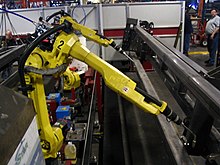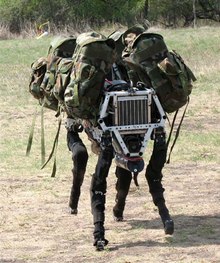
Back Robot Afrikaans Roboter ALS ሮቦት Amharic Robot AN Searuþræl ANG Rọbọt ANN روبوت Arabic ৰবট Assamese Robó AST Robot Azerbaijani



A robot is a machine—especially one programmable by a computer—capable of carrying out a complex series of actions automatically.[2] A robot can be guided by an external control device, or the control may be embedded within. Robots may be constructed to evoke human form, but most robots are task-performing machines, designed with an emphasis on stark functionality, rather than expressive aesthetics.
Robots can be autonomous or semi-autonomous and range from humanoids such as Honda's Advanced Step in Innovative Mobility (ASIMO) and TOSY's TOSY Ping Pong Playing Robot (TOPIO) to industrial robots, medical operating robots, patient assist robots, dog therapy robots, collectively programmed swarm robots, UAV drones such as General Atomics MQ-1 Predator, and even microscopic nano robots. By mimicking a lifelike appearance or automating movements, a robot may convey a sense of intelligence or thought of its own. Autonomous things are expected to proliferate in the future, with home robotics and the autonomous car as some of the main drivers.[3]
The branch of technology that deals with the design, construction, operation, and application of robots,[4] as well as computer systems for their control, sensory feedback, and information processing is robotics. These technologies deal with automated machines that can take the place of humans in dangerous environments or manufacturing processes, or resemble humans in appearance, behavior, or cognition. Many of today's robots are inspired by nature contributing to the field of bio-inspired robotics. These robots have also created a newer branch of robotics: soft robotics.
From the time of ancient civilization, there have been many accounts of user-configurable automated devices and even automata resembling humans and other animals, such as animatronics, designed primarily as entertainment. As mechanical techniques developed through the Industrial age, there appeared more practical applications such as automated machines, remote-control and wireless remote-control.
The term comes from a Slavic root, robot-, with meanings associated with labor. The word "robot" was first used to denote a fictional humanoid in a 1920 Czech-language play R.U.R. (Rossumovi Univerzální Roboti – Rossum's Universal Robots) by Karel Čapek, though it was Karel's brother Josef Čapek who was the word's true inventor.[5][6][7] Electronics evolved into the driving force of development with the advent of the first electronic autonomous robots created by William Grey Walter in Bristol, England in 1948, as well as Computer Numerical Control (CNC) machine tools in the late 1940s by John T. Parsons and Frank L. Stulen.
The first commercial, digital and programmable robot was built by George Devol in 1954 and was named the Unimate. It was sold to General Motors in 1961 where it was used to lift pieces of hot metal from die casting machines at the Inland Fisher Guide Plant in the West Trenton section of Ewing Township, New Jersey.[8]
Robots have replaced humans[9] in performing repetitive and dangerous tasks which humans prefer not to do, or are unable to do because of size limitations, or which take place in extreme environments such as outer space or the bottom of the sea. There are concerns about the increasing use of robots and their role in society. Robots are blamed for rising technological unemployment as they replace workers in increasing numbers of functions.[10] The use of robots in military combat raises ethical concerns. The possibilities of robot autonomy and potential repercussions have been addressed in fiction and may be a realistic concern in the future.
- ^ "Four-legged Robot, 'Cheetah,' Sets New Speed Record". Reuters. 6 March 2012. Archived from the original on 22 October 2013. Retrieved 5 October 2013.
- ^ Definition of 'robot'. Oxford English Dictionary. Retrieved 27 November 2016.
- ^ "Forecasts – Driverless car market watch". driverless-future.com. Retrieved 26 September 2023.
- ^ "robotics". Oxford Dictionaries. Archived from the original on 18 May 2011. Retrieved 4 February 2011.
- ^ Margolius, Ivan (Autumn 2017). "The Robot of Prague" (PDF). The Friends of Czech Heritage (17): 3–6. Archived (PDF) from the original on 11 September 2017.
- ^ Zunt, Dominik. "Who did actually invent the word "robot" and what does it mean?". The Karel Čapek website. Archived from the original on 4 February 2012. Retrieved 11 September 2007.
- ^ Kurfess, Thomas R. (1 January 2005). Robotics and Automation Handbook. Taylor & Francis. ISBN 978-0-8493-1804-7. Archived from the original on 4 December 2016. Retrieved 5 July 2016 – via Google Books.
- ^ Pearce, Jeremy (15 August 2011). "George C. Devol, Inventor of Robot Arm, Dies at 99". The New York Times. Archived from the original on 25 December 2016. Retrieved 7 February 2012.
In 1961, General Motors put the first Unimate arm on an assembly line at the company's plant in Ewing Township, N.J., a suburb of Trenton. The device was used to lift and stack die-cast metal parts taken hot from their molds.
- ^ Akins, Crystal. "5 jobs being replaced by robots". Excelle. Monster. Archived from the original on 24 April 2013. Retrieved 15 April 2013.
- ^ Hoy, Greg (28 May 2014). "Robots could cost Australian economy 5 million jobs, experts warn, as companies look to cut costs". ABC News. Australian Broadcasting Corporation. Archived from the original on 29 May 2014. Retrieved 29 May 2014.